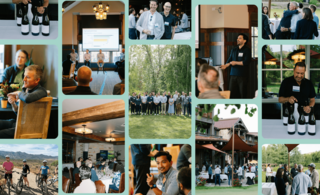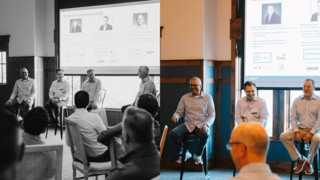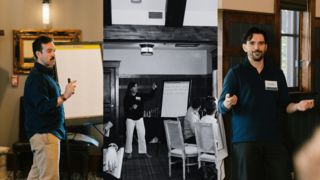Portfolio Events| September 2025
Inside the 2025 Finance Leaders Summit: Higher Standards, Stronger Tools

Earlier this month, more than 30 finance leaders from across the Spectrum portfolio and community gathered in Park City for our 2025 Finance Leader Summit.
Set against Utah’s Wasatch mountains (and in perfect September weather), the Summit offered two days of dialogue, workshops, and connection, all designed to equip attendees with new ideas, sharper strategies, and wider circles of support.

Reception followed by "State of the Portfolio" presentation
The Summit opened with dinner and a State of the Portfolio conversation, led by Spectrum CFO Brian Regan and Director of Portfolio Analytics, Reporting, and FP&A Tom Moll. Over the meal and lively reception, the tone was set for the days ahead: collaborative, pragmatic, and forward-looking.
AI at the Center of the Conversation
Unsurprisingly, the expanding role of AI in the finance function was a central theme of the event. The first day kicked off with a round table on AI with Spectrum portfolio CFOs Bill McNamara (Zenwork) and John Granara (CINC Systems), joined by outside expert Vipul Shah of FinQore.

From left: Vipul Shah, Brian McNamara, John Granara, Brian Regan
Panelists and participants focused on tangible examples, sharing how they are experimenting with AI and how they have already operationalized it to deliver measurable value:
- Organizational adoption: CINC Systems has embedded AI into every department, gamifying innovation through monthly prizes for productivity breakthroughs. While this cultural shift has been led by their CEO, John emphasized that every leader of CINC has embraced it – and that CFOs are just as responsible for AI adoption within their function.
- Customer experience: Zenwork has used AI to raise its support deflection rate – dramatically increasing their response time, while also improving the quality of their support for complex questions.
- Employee retention. Vipul, who works with a wide range of finance leaders, advised the group to think of AI as a retention play. “Every CFO has a right-hand person they never want to lose – and that person is getting burned out,” he noted. “AI becomes a way to keep your best people doing strategic work where they have the most value.
The discussion also underscored an important tension: balancing speed with accuracy. As Vipul Shah reminded the group, AI doesn’t need to be perfect to be powerful. As with all things in finance, its outputs still require verification.
Interactive Workshops: “Optimizing Monetization,” and “AI-Enhanced Strategic Planning and OKRs”
For the second half of the morning, leaders broke into interactive workshops designed to spark peer-to-peer learning and practical takeaways.

From left: Ian Clark, Coley Florance, Harry Siggins
Workshop: Optimizing Monetization
In Optimizing Monetization, Ian Clark of Crescendo Consulting pushed leaders to use pricing as an unlock for hidden revenue opportunities. “Pricing has a greater impact on your business than customer acquisition, customer retention, and cost,” said Ian,noting that pricing influences every part of a go-to-market strategy, from product to marketing to sales.
Key takeaways from Ian’s session included:
1. Pricing is your most powerful growth lever.
Small shifts in pricing deliver outsized impact compared to acquisition, churn, or cost-cutting. A 10% annual improvement in price drives far greater gains in revenue and EBITDA than the same improvement in new logos, CAC, or retention.
2. Choose the right pricing architecture.
Pricing isn’t just about the number – it’s about metrics, packaging, and structure. Whether you charge per user, bundle features into “good-better-best” tiers, or adopt usage-based pricing, your choices should align with customer willingness-to-pay and segment needs. Getting the wrong metric or structure can stall adoption or leave money on the table.
3. Packaging and bundling shape perception of value.
How you organize and present value matters as much as the price tag. Bundling “leaders” with “fillers,” offering add-ons, or segment-based tiers can drive adoption and upsell opportunities. The golden rule: your packaging should mirror your customer segmentation – simple for single-segment plays, more complex as markets diversify.
Workshop: AI and OKRs
In our second workshop, AI-Enhanced Strategic Planning and OKRs, Harry Siggins of OneTwo Growth Studio helped attendees translate emerging tools into sharper planning processes. He started by reminding the group why OKRs have such high stakes: they can determine whether teams focus on the most important work, stay accountable for results, and ultimately drive company success.
1. Strategy breaks where structure is weakest
Harry introduced the Strategic Planning Loop (ideation → deployment → execution → synthesis) and had leaders score themselves across 12 dimensions. The exercise revealed that weak points (whether in visibility, accountability, or support) become leverage points. In other words: your strategy loop is only as strong as its weakest link.
2. AI works best in small, testable experiments
Rather than aiming for transformation overnight, Harry emphasized the “20% Promise” – designing targeted AI experiments that deliver specific improvements and compound weekly. The “Experiment Canvas” helped attendees define a problem, current process, AI enhancement idea, MVP, and success metric.
3. Strategic focus requires visible ownership
Tools alone won’t fix broken planning; the three pillars of visibility, accountability, and support are what stabilize strategic execution. Leaders must ensure that initiatives have named owners, progress is transparent, and leadership models focus instead of drowning in ops.

Connections Beyond the Sessions
Executives in all functions can struggle to find community – leaders have less time to invest in networking, and fewer peers at their level. To that end, the time together was also about informal knowledge sharing across the Spectrum portfolio, during mountain hikes, golf games, and (for a few adventurous attendees) archery lessons.
We’re grateful to all of the experts, community members, and portfolio finance leaders who joined us. Until the next Summit – we’ll be carrying the ideas and connections forward, and finding new ways to put them to work.
The content on this site, including but not limited to blog posts, portfolio news, Spectrum news, and external coverage, is for informational purposes only and does not constitute investment advice. Use of any information presented is at your own risk. Spectrum Equity is not responsible for any content reposted above from any third party website, and has not verified the accuracy of any third party content contained above. Spectrum Equity makes no guarantees or other representations regarding any results that may be obtained from use of this content. Investment decisions should always be made in consultation with a financial advisor and based on individual research and due diligence. Past performance is not indicative of future results, and there is a possibility of loss in connection with an investment in any Spectrum Fund.
Inclusion in any third-party list, award, rating, ranking, or other recognition is not indicative of Spectrum Equity’s future performance and may not be representative of any investor’s experience. To the fullest extent permitted by law, Spectrum Equity disclaims all liability for any inaccuracies, omissions, or reliance on the information, analysis, or opinions presented.